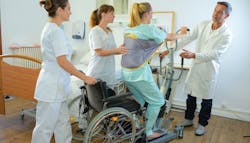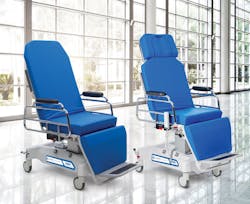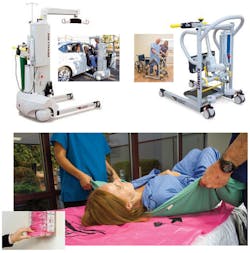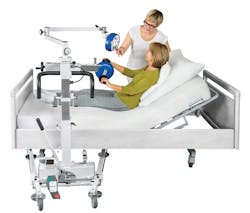Operating Room
Caregiving can be back-breaking work. Literally. Caregivers can do serious damage to their bodies during the course of performing their daily duties. Debilitating pain, a long physical rehabilitation period, and/or surgeries may render them unable to continue working in their chosen profession.
A study by Weinmeyer1 outlines three factors accounting for the rise in workplace injuries. The first factor is the shortage of nurses. He referred to a study by Buerhaus et al,2 which estimated there may be “as many as 260,000 unfilled nursing posts in the U.S. by the year 2025.” The second factor cited is the increase in rates of obesity, with healthcare workers (HCWs) caring for heavier and sicker patients. Referring to findings from a study by Zwerdling,3 Weinmeyer said, “Nurses and staff must regularly maneuver patients who weigh 300 pounds or more and whose limbs alone can weigh 60-70 pounds.” The third factor is the increase in outpatient clinics, with hospital beds more often reserved for more seriously ill patients. Again referring to Zwerdling’s3 study, Weinmeyer stated, “... staff members are encouraged to help patients get out of bed and move as often as possible, even though these patients might have limited ability to move under their own power.” Assisting patients with moving around their rooms, repositioning them in their beds, and other tasks requiring physical support of patients offers many opportunities for workplace injuries.
Bigger patients, bigger risks
The National Institute for Occupational Safety and Health (NIOSH) found that rates of HCW musculoskeletal injuries are the highest of all U.S. industries. “Data from the Bureau of Labor Statistics (BLS) show that in 2014, the rate of overexertion injuries averaged across all industries was 33 per 10,000 full-time workers. By comparison, the overexertion injury rate for hospital workers was twice the average (68 per 10,000), the rate for nursing home workers was over three times the average (107 per 10,000), and the rate for ambulance workers was over five times the average (174 per 10,000). The single greatest risk factor for overexertion injuries in healthcare workers is the manual lifting, moving and repositioning of patients, residents or clients, i.e., manual patient handling.”4
Time to get serious
Clearly, what is needed is a program for safe patient handling that benefits the health of both staff and patients. “The benefits of implementing a safe patient-handling program in the operating room (OR) for the patient are decreased moving and positioning injuries, decreased falls, and increased safety,” said Ogg, AORN. “For the perioperative team, the benefits are reduced work-related musculoskeletal injuries, reduced risk and severity of lifting and repositioning injuries, increased quality of life, and decreased fatigue.” Ogg noted that the hospital benefits as well. “For the hospital, the benefits are decreased workers’ compensation costs, decreased employee turnover, and increased HCW morale.”
Ogg referred to AORN’s Guideline for Safe Patient Handling and Movement,5 which “outlines the use of seven ergonomic tools designed to eradicate work-related musculoskeletal injuries. The tools provide guidance and algorithms for transferring and positioning patients in the supine, prone, semi-fowlers, lithotomy, and lateral positions; lifting and holding extremities for surgical prepping; prolonged standing; and lifting and moving heavy instruments and equipment.
“The technology for safe patient handling in the OR has not kept pace with the technology used in other areas of the hospital,” continued Ogg. “The use of ceiling lifts for lifting, moving, and positioning patients on the nursing units is increasing; however, in the OR, there are very few available for use. Primarily, the equipment used to move patients in the OR are slide boards, friction-reducing sheets, and roller boards. There is increased use of air-assisted lateral transfer devices, but only for bariatric patients. According to the algorithm, a lateral transfer device should be used for all patients over 157 pounds. Motorized stretchers can help the perioperative team with transport. Manufacturers are listening to the concerns of the OR team and, hopefully, in the future, there will be equipment to help all OR personnel with safe patient handling.”
Eric Race, President and Founder, Atlas Lift Tech, Inc., added, “Despite legislation and best practice, less than eleven percent of 5,500 acute-care facilities have a safe patient-handling program in place.6 The obesity rate in America continues to climb, and, in effect, so does the rate of workplace injuries related to lifting or transporting patients. Best-practice research discourages any worker from manually lifting over 35 pounds,4 and, in the care setting, many of the factors that contribute to the rise in injuries can be mitigated. By leveraging intelligent software, daily support, and cutting-edge assistive devices, we can achieve mobility done safely.”
Cost of doing nothing
Race addressed the costs associated with workplace injury. “As workers’ compensation claims for patient-handling injuries amount to over $7.4 billion nationally, and associated soft costs are two to three times that amount, implementing a sustainable program is of financial benefit.7 A program that promotes mobility done safely produces remarkable benefits. Care staff and patient-injury rates plummet. Our programs have resulted in over an eighty-percent reduction in workers’ compensation claims, sixty-five percent decrease in injury rates, and eighty-nine percent decrease in cost per injury. Staff can continue the work they love, patients spend fewer days in the hospital, and hospitals apply their cost-savings to other priorities.”
Describing how their program works to reduce workplace injury, Race continued, “Atlas Lift Tech combines bedside training by Atlas Lift Coaches and Program Managers, and technology integration by way of a proprietary HIPAA-compliant software platform, LiftTracker. LiftTracker provides direct access to Lift Coaches, tracks compliance and bedside training, and generates predictive analytics about the programmatic health and performance of a facility’s safe patient-handling program. Lift Coaches are on-site at client facilities and are responsible for implementation and maintenance of injury-reduction programs. Atlas Lift Coaches are badged at the facility; however, Atlas maintains responsibility for liability and payroll.”
Worth the investment
Race referred to Cedars Sinai Medical Center’s experience with Atlas, where their program helped the hospital to save over $4 million in a single year. He also pointed to a paper published by Stanford Risk Authority that concluded “The value of implementing the [Atlas Lift Tech] program in terms of savings of hard and soft costs was estimated to be several multiples of the cost of implementing and maintaining the program annually.”6
Mark Lazzeri, TransMotion Marketing Product Manager, Winco Mfg., LLC, noted, “There are several references in the literature where safe patient-handling investments have paid for themselves in a short period of time. Safe patient handling can also play a major role in patient satisfaction scores and the overall patient experience.
“At Winco Mfg., our corporate mission is ‘Enhancing the Patient and Caregiver Experience,’ Lazzeri pointed out. “We provide customers with product solutions that support a safe patient-handling environment. For more than a decade, the TransMotion Series Stretcher-Chair has helped eliminate patient transfers via our ‘One Patient, One Surface’ solution.” The TMM series features innovative powered patient positioning at the push of a button. The forty-inch stretcher height maximizes accessibility to the operative site while minimizing stress and fatigue on the physician. Patients remain in the chair from pre-op to procedure to recovery, thereby eliminating patient transfers, reducing patient and staff injuries and workman’s comp costs to the hospital.”
Lazzeri shared the experience of a client, Bascom Palmer Eye Institute, Miami FL. “Their goal was creating a no-lift, no-transfer environment in the OR, addressing three high-profile operational and safety issues: (1) patient fall hazards, (2) risk of injury to staff, and (3) efficient patient flow. A ‘zero-transfer solution’ was implemented utilizing the TransMotion TMM5 Surgical Eye Stretcher Chair. Patients remained in the same chair through all phases of their procedure, thus eliminating transfers that could be hazardous to both patients and staff members. The goal was reached, as there were no patient falls and no workers’ compensation cases regarding back pain from transferring patients and increased patient flow.8
Amber Perez, MHA, CSPHP, Director of Clinical Services, Wy’East Medical, reiterated that NIOSH determined 35 pounds is the safe lifting limit for caregivers.9 “Without appropriate safe patient-handling equipment, most patients exceed this limit.”
”Safe patient-handling and mobility programs pair safe solutions with daily tasks and demands of the caregiver,” said Perez. “Proper implementation results in safer practices and helps reduce caregiver patient-handling injuries, reduces witnessed or assisted falls, and promotes early and progressive mobility programs, which are proven to reduce patient falls, hospital-acquired pressure injuries, ventilator-acquired pneumonia, and length of stay, and improves hospital-discharge disposition. Patients are more likely to go home than to a nursing home or care facility.”
Perez described their TotaLift chair as used for early mobility for even the most critically ill patients. The Denali 600 is a fully powered, drivable, mobile-dependent lift capable of extracting patients from cars. The Vista is a 600-pound–capacity mobile-dependent lift. The Summit is a 500-pound–capacity powered stand-assist device, with optional oxygen tank holder and infusion pole, with removable footplate. The Vista is a 400-pound–capacity non-powered stand aid with removable footplate and accessories. The Pink Slip is a pocket-sized friction-reducing slide sheet for repositioning and transferring patients that reduces the push/pull forces, protecting patients’ delicate skin by reducing friction and shear, two major causative factors in developing pressure injuries.”
Perez, a former Injury Prevention Specialist from Banner Health, and her team helped develop and validate the Bedside Mobility Assessment Tool (BMAT).10 “This tool teaches nurses to assess a patient’s level of functional mobility and correlates the mobility level with a type of safe patient-handling and mobility equipment, promoting maximum patient participation and minimal risk of injury.
“The pilot facility at Banner Baywood Medical Center saw over seventy-five percent reduction in patient-handling injuries within the first year; assisted or witnessed patient falls were eliminated for twelve months and then maintained below national benchmarks; and the BMAT was instrumental in the implementation of early mobility in the intensive-care unit. Since then, BMAT has been implemented at Duke University Hospitals, UCLA Medical Center, SCL Health, Maine Health, Veterans’ Health Administration Hospitals all across the United States, and more.
Wy’East’s patient-handling equipment is coupled with a program-support division called Sustainable Patient Handling Solutions. “We believe in providing affordable or even no-cost support to help our customers implement evidence-based long-term solutions, sustainably.” Free education and resources are available at www.sph-solutions.com.
Katie Kramer, Marketing Communication Manager, HoverTech International, described the HoverMatt Single-Patient Use (SPU) Air Transfer System as an “air-assisted device that allows caregivers to laterally transfer and position patients safely and easily. When inflated, a cushion of air beneath the mattress reduces the force needed to move the patient by eighty to ninety percent. The HoverMatt SPU also reduces friction and skin shear. Its highly breathable fabric provides the ideal microclimate for pressure-injury prevention. Addressing these factors for skin safety is critical now that hospital-acquired pressure injuries are no longer reimbursed.
“For patient falls, the HoverJack Air Patient Lift inflates to allow caregivers to lift patients safely from the floor to bed or stretcher height in a supine position, maximizing patient comfort and dignity, and minimizing the risk of injury to both patient and caregiver.”
Kramer related the experience of Moffitt Cancer Center in Tampa, FL, which implemented the HoverMatt Single-Patient Use Air Transfer System “to address a high rate of lifting and transferring injuries that resulted in direct costs of over $250,000 annually and indirect costs, including modified duty and lost work days. HoverTech’s Consignment Program was utilized to outfit the facility with SPUs, air supplies, and storage/transport carts. One year later, staff lifting injuries were cut in half and the total direct cost of lifting injuries was reduced by over ninety-six percent. With the addition of more equipment and further staff training the subsequent year, Moffitt ultimately recognized a ninety-eight percent dollar decrease in direct costs. Lost days due to lifting injuries dropped ninety-six percent, from 183 in 2009 to seven in 2011. Modified duty days decreased by eighty-eight percent, from 638 in 2009 to seventy-seven in 2011.”
Mike Laky, Chief Executive Officer, Enable Me, said, “Workman’s compensation claims in the healthcare industry are led by back injuries to nurses, physical therapists, and other HCWs. By implementing a safe patient-handling program, injury to staff and the reduction of Never Events (ie, falls) can be reduced considerably.
“Teaching staff members proper body mechanics when moving or assisting a patient is the first step,” continued Laky. “The use of patient lifts and overhead tracking systems also is an important part of the program. Devices, such as the RECK Letto and MOTOmed, distributed by Enable Me, allow the patient to enjoy meaningful therapy without being transferred from a bed or wheelchair.”
Laky pointed to a study by Parker et al11 that emphasized the importance of starting rehabilitation early. “Survivors of critical illness often experience new or worsening impairments of physical, cognitive, and/or mental health, referred to as Post-Intensive Care Syndrome (PICS). Such impairments can be long-lasting and negatively affect survivors’ quality of life. Early rehabilitation in the intensive care unit (ICU), while patients remain on life-support therapy, may reduce the complications associated with PICS.”11
References
1. Weinmeyer R. Safe patient handling laws and programs for health care workers. AMA J Ethics. 2016;18(4):416-421. https://journalofethics.ama-assn.org/article/safe-patient-handling-laws-and-programs-health-care-workers/2016-04. Last accessed April 29, 2019.
2. Buerhaus PI, Auerbach DI, Staiger DO. The recent surge in nurse employment: causes and implications. Health Aff (Millwood). 2009;28(4):w657-w668.
3. Zwerdling D. Hospitals fail to protect nursing staff from becoming patients [transcript]. NPR. February 4, 2015. http://www.npr.org/2015/02/04/382639199/hospitals-fail-to-protect-nursing-staff-from-becoming-patients. Last accessed April 29, 2019.
4. Centers for Disease Control and Prevention. The National Institute for Occupational Safety and Health. Workplace safety and health topics. Safe patient handling and mobility (SPHM). https://www.cdc.gov/niosh/topics/safepatient/. Last accessed April 29, 2019.
5. Hauk L. Guideline for safe patient handling and movement. AORN J. 2018 Jun;107(6):P10-P12.
6. Vaughan J, Driver J, Hall E, et al. A new model for successful safe patient handling programs. Proceedings of the 5th International Conference on Applied Human Factors and Ergonomics; Kraków, Poland: July 19-23, 2014.
7. Waehrer G, Leigh JP, Miller TR. Costs of occupational injury and illness within the health services sector. Int J Health Serv. 2005;35(2):343-359.
8. Timmons L. Creating a no-lift no-transfer environment in the OR. AORN J. 2009;89(4):733-736.
9. Waters TR, Putz-Anderson, V, Garg A. Applications Manual for the Revised NIOSH Lifting Equation. U.S. Department of Health and Human Services, Public Health Service, Centers for Disease Control and Prevention, National Institute for Occupational Safety and Health, Division of Biomedical and Behavioral Sciences. Cincinnati, Ohio: 1994. https://www.cdc.gov/niosh/docs/94-110/pdfs/94-110.pdf?id=10.26616/NIOSHPUB94110. Last accessed May 2, 2019.
10. Boynton T, Kelly L, Perez A, et al. Banner Mobility Assessment Tool for Nurses: instrument validation. Am J SPHM. 2014;4(3):86-92.
11. Parker A, Sricharoenchai T, Needham DM. Early rehabilitation in the intensive care unit: preventing physical and mental health impairments. Curr Phys Med Rehabil Rep. 2013 Dec;1(4):307-314.
About the Author

Susan Cantrell
Susan Cantrell is Infection Prevention Editor for Healthcare Purchasing News.






